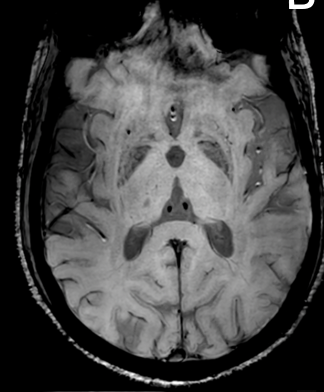Category: Rare Genetic and Metabolic Diseases
Objective: To describe certain unique clinical and imaging features in a patient with RNF216-associated neuro degeneration (RNF216-AN)
Background: RNF216-AN, known as Gordon Holmes syndrome is a disorder of impaired ubiquitination, presenting with ataxia, dementia and hypogonadotropic hypogonadism (HH). We describe a 38-year-old with unique clinical and imaging features which were not described before.
Method: Case report of a patient collected as a part of an ambispective study done at department of Neurology, NIMHANS
Results: The present case is a 38-year-old, born to consanguineous parents, normal birth and development, presented with 10-yr duration of choreiform movements started in lower limbs followed by trunk, upper limbs with worsening in last 2 yr. He developed posturing of limbs for 8 yr, imbalance with falls for 2 yr along with peri-oral pursing movements, speech, swallowing difficulty and memory decline for 4 months. Family history was significant in two maternal cousins. On examination, he had short stature (152 cm), small head circumference (52 cm), absent secondary sexual characters (Tanner’s 2), kypho-scoliotic spine deformity, low set ears, hypertelorism. He had impaired attention, executive dysfunction, memory, fluency (MOCA 9/30, ACE III 41/100), cerebellar dysarthria, normal vision and fundus. EOM were full with slow, hypometric saccades and saccadic-pursuits and head thrusts. He had facial chorea with intermittent eye lid elevation, perioral movements, darting tongue and upper and lower limb chorea, truncal and hand dystonia. Cerebellar signs were positive. DTR were exaggerated. Patient walks with support with wide based gait with choreoathetoid movements of limbs with truncal dystonia to left. UCARS 46/84, BFMDRS motor 75/120 and disability 25/30 and ICARS 77/100. MRI brain showed cerebellar and cerebral atrophy,T2 FLAIR WM changes, mineralisation of GP. Genetics showed novel homozygous pathogenic mutation on Chr 7, exon 12 (g.5752495C>T) with c.1663-1G>A transition suggestive of RNF216-AN.
Conclusion: RNF216-AN presents with ataxia, dementia and HH. We describe a patient with RNF216-AN with unique features of severe dystonia and chorea with predominant orolingual involvement along with other described features such as ataxia, dementia and HH and mineralisation of GP raising the possibility if RNF216-AN is a new NBIA disorder.
To cite this abstract in AMA style:
NS. Sriram. RNF216–associated neurodegeneration: Is it a new NBIA disorder? [abstract]. Mov Disord. 2023; 38 (suppl 1). https://www.mdsabstracts.org/abstract/rnf216-associated-neurodegeneration-is-it-a-new-nbia-disorder/. Accessed December 15, 2025.« Back to 2023 International Congress
MDS Abstracts - https://www.mdsabstracts.org/abstract/rnf216-associated-neurodegeneration-is-it-a-new-nbia-disorder/

